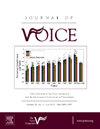声乐表现问卷在卡纳达语中的跨文化改编和验证。
IF 2.5
4区 医学
Q1 AUDIOLOGY & SPEECH-LANGUAGE PATHOLOGY
引用次数: 0
摘要
背景/目的:声乐表现问卷(VPQ)是一种简短而方便的声乐表现评估工具,具有一维一致性。开发卡纳达语版本的 VPQ 可以作为一种有用的自我评估临床工具,用于评估卡纳达语患者的发音障碍症状。因此,本研究的目的是将 VPQ 翻译成卡纳达语,并评估卡纳达语版 VPQ(VPQ-K)的心理测量特性和临界分数:研究设计:本次调查采用了非随机、前瞻性的标准组比较方法:方法:将 VPQ 翻译成卡纳达语,并对 71 名被诊断为嗓音障碍的参与者(37 名男性和 34 名女性)(平均年龄为 43.94 ± 15.31 岁)和 71 名年龄和性别匹配、临床嗓音正常的参与者进行测试:通过类内相关测量了 VPQ-K 的重测可靠性,结果表明重测可靠性极佳。通过计算斯皮尔曼-布朗系数(Spearmen-Brown coefficient)来确定 VPQ-K 的内部一致性,结果显示 VPQ-K 具有很强的内部一致性。结果还显示,与研究组的参与者相比,对照组参与者的 VPQ-K 分数明显较低,这表明 VPQ-K 具有良好的建构效度。受试者操作特征曲线(ROC)分析表明,VPQ-K 的临界点为 18.50:由于 VPQ-K 是一种快速、易于填写且负担较小的自我评估工具,因此建议将 VPQ-K 作为一种灵敏的临床工具,用于评估讲卡纳达语的嗓音疾病患者的发声表现和治疗效果。本文章由计算机程序翻译,如有差异,请以英文原文为准。
Cross-cultural Adaptation and Validation of the Vocal Performance Questionnaire into Kannada
Background/Objectives
Vocal Performance Questionnaire (VPQ) is a short and convenient tool with one-dimensional consistency to evaluate the vocal performance. Developing the Kannada version of VPQ can be a useful self-assessment clinical tool for evaluating dysphonia symptoms in Kannada-speaking patients. Hence, the objective of the study was to translate the VPQ into Kannada and to evaluate the psychometric properties and the cutoff scores for the Kannada version of the VPQ (VPQ-K).
Study design
This investigation deployed a non-randomised, prospective standard group comparison.
Methods
VPQ was translated to Kannada and administered to 71 participants (37 males and 34 females) diagnosed with voice disorder with a mean age of 43.94 ± 15.31 years and 71 age and gender-matched participants with a clinically normal voice.
Results
The test-retest reliability of the VPQ-K was measured through Intra class correlation, and the results indicated excellent test-retest reliability. The Internal consistency of VPQ-K was determined using the Split half reliability by calculating the Spearmen-Brown coefficient, and the results revealed that VPQ-K had very strong internal consistency. Results also indicated that the participants in the control group had significantly lower VPQ-K scores compared to the participants in the study groups, indicating that VPQ-K had good construct validity. Receiver Operating Characteristic (ROC) curve analysis showed a cutoff point of 18.50 for VPQ-K.
Conclusions
As VPQ-K is a quick, easy to fill and low-burden self-assessment tool, VPQ-K can be proposed as a sensitive clinical tool to assess the vocal performance in Kannada-speaking patients with voice disorders and to evaluate the treatment outcome.
求助全文
通过发布文献求助,成功后即可免费获取论文全文。
去求助
来源期刊

Journal of Voice
医学-耳鼻喉科学
CiteScore
4.00
自引率
13.60%
发文量
395
审稿时长
59 days
期刊介绍:
The Journal of Voice is widely regarded as the world''s premiere journal for voice medicine and research. This peer-reviewed publication is listed in Index Medicus and is indexed by the Institute for Scientific Information. The journal contains articles written by experts throughout the world on all topics in voice sciences, voice medicine and surgery, and speech-language pathologists'' management of voice-related problems. The journal includes clinical articles, clinical research, and laboratory research. Members of the Foundation receive the journal as a benefit of membership.
 求助内容:
求助内容: 应助结果提醒方式:
应助结果提醒方式:


